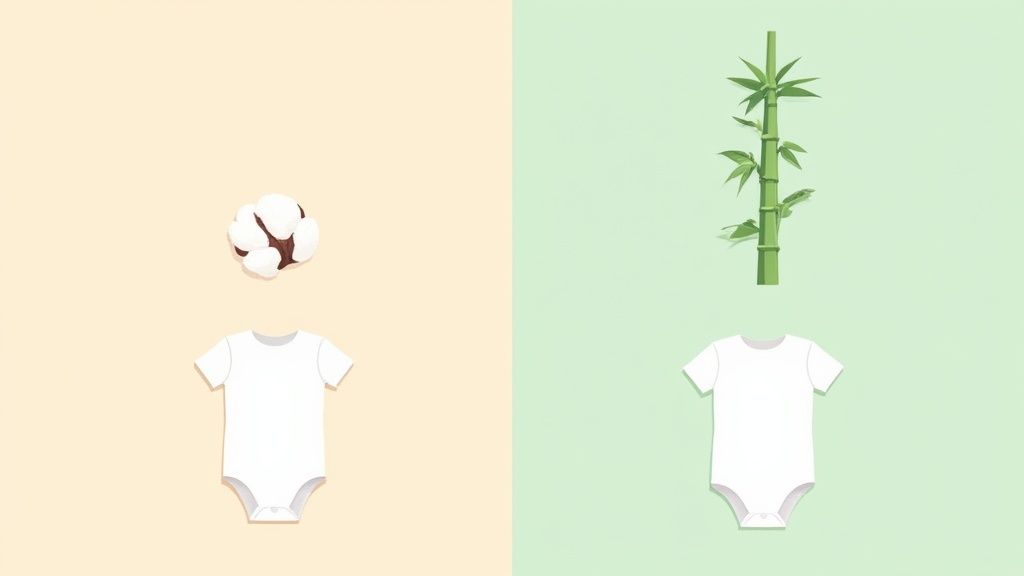
Organic Cotton vs Bamboo The Ultimate Baby Fabric Guide
Share
When you're trying to decide between organic cotton and bamboo for your baby, it really boils down to this: organic cotton is prized for its certified purity and breathability, while bamboo viscose is loved for its silky softness and temperature regulation. The best choice often depends on what you value most—unmatched gentleness for sensitive skin or next-level comfort for sleep and play.
Choosing The Best Fabric For Your Baby
Welcome to the great fabric debate that every new parent seems to have. When you're dressing your little one, comfort and safety are obviously top of mind, but these days, sustainability is a huge piece of the puzzle, too. This guide is here to cut through all the marketing noise and give you a straight-up, side-by-side comparison of organic cotton and bamboo.
We'll get into everything from how they actually feel on delicate skin to their true environmental footprint, helping you make a choice that you can feel genuinely good about.
Quick Look Organic Cotton vs Bamboo At a Glance
Let's start with a high-level summary of the key differences between these two fabrics before we dive deeper into the nitty-gritty details.
| Feature | Organic Cotton | Bamboo Viscose |
|---|---|---|
| Feel & Texture | Soft, crisp, and gets even softer with every wash. Very breathable. | Silky, smooth, and drapes beautifully. Often feels cool to the touch. |
| Best For Skin | Excellent for highly sensitive or eczema-prone skin because it's so pure. | Hypoallergenic, but there's a small chance of chemical residue from processing. |
| Sustainability | Uses a lot of water but avoids harsh pesticides and helps keep soil healthy. | Grows incredibly fast and uses less water, but the chemical processing is a major concern. |
| Care & Durability | Super durable and can handle frequent, hot washes without a problem. | More delicate; needs a gentle, cool wash to avoid pilling and stretching. |
This whole shift toward better fabrics is really being driven by parents like you. The global organic cotton market was estimated to be worth approximately $2.5 billion in 2025 and is expected to hit around $4.5 billion by 2033. That growth is a direct result of parents demanding safer, more sustainable options for their kids. You can find more market insights over at DataInsightsMarket.com.
This image really helps visualize the environmental data, comparing water usage, CO2 emissions, and land required for each fabric.
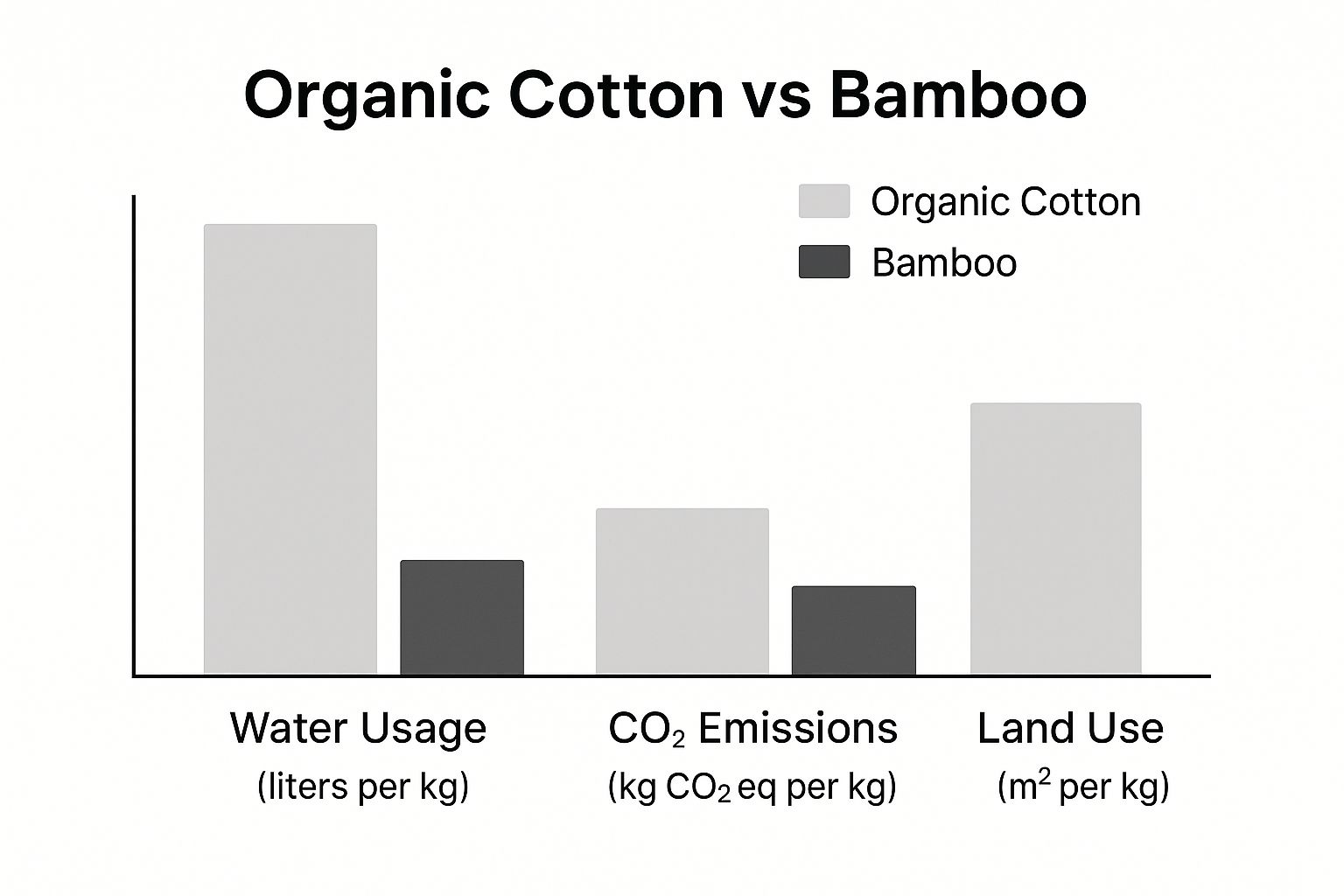
As you can see, the chart highlights organic cotton’s higher water consumption, while bamboo typically needs less land and has a different emissions profile. Honestly, both fabrics are a massive improvement over conventional materials, especially when you're looking for the best fabric for sensitive skin.
Let's Talk Softness and Breathability
When you're dressing a baby, comfort is everything. The whole organic cotton vs. bamboo debate usually kicks off right here: which one feels better against that perfect, delicate skin? It’s often the first thing parents think about, and honestly, both fabrics bring something special to the table.
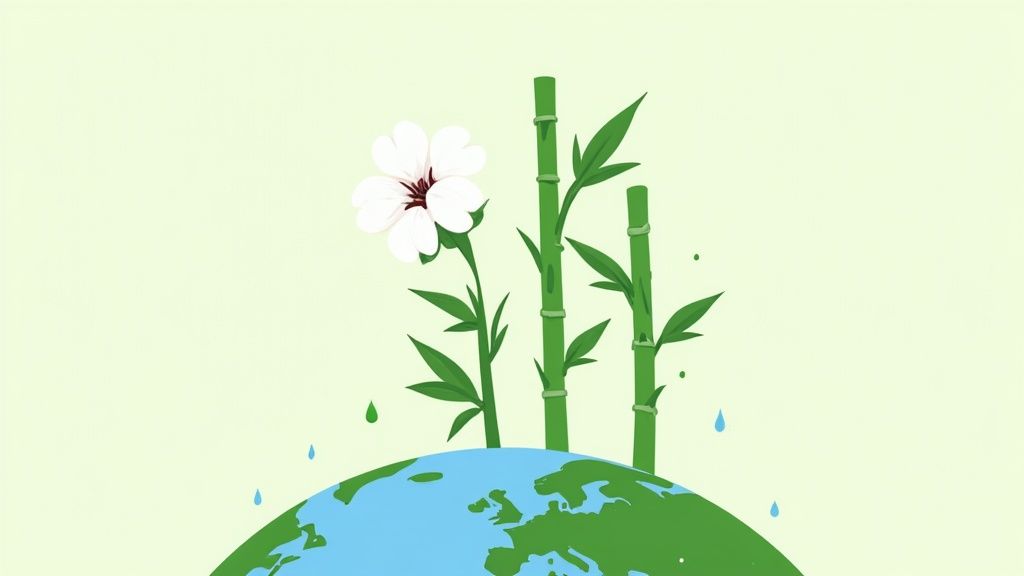
Bamboo viscose has a reputation for being almost ridiculously soft. We're talking silky, buttery, and drapey. It has this luxurious feel that you'd normally associate with something high-maintenance like silk, but it’s way easier to care for. That slick, smooth surface just glides over the skin, which is a huge win for wriggly babies because it cuts down on friction and irritation.
Organic cotton has a different kind of softness. It’s that classic, cozy feel you get from your favorite, well-loved t-shirt. It might not have that initial "wow" silkiness of bamboo, but it's a durable softness that gets even better with every wash. It becomes cozier and cozier without falling apart.
The All-Important Breathability Factor
Let's get real about baby clothes—they have to breathe. Babies aren't great at regulating their own body temperature, so overheating is a real concern. This is where the actual structure of the fibers makes a massive difference.
Organic cotton is the undisputed champion of breathability. Its natural fibers are porous, letting air flow right through. This simple, brilliant design helps whisk heat and moisture away from your baby’s skin, keeping them cool and comfy. It’s a lifesaver for preventing heat rash, especially during naptime or on a hot day.
If you have a summer baby or one who just seems to run hot all the time, organic cotton is a no-brainer. Its airy quality makes it perfect for swaddles, onesies, and any lightweight layers you need for warmer weather.
Bamboo viscose is also breathable, but it works a bit differently. It's incredibly moisture-wicking, meaning it pulls sweat away from the skin to the fabric's surface where it can evaporate. This keeps your baby feeling dry, which is another key part of staying comfortable.
Keeping Comfy All Year Round with Thermal Regulation
Beyond just letting air through, the right fabric needs to keep your baby comfortable whether you're in a freezing, air-conditioned store or a stuffy car.
This is where bamboo really shines. The fibers have these tiny micro-gaps that trap air, creating a natural insulating layer. It sounds technical, but what it means is that bamboo helps keep your baby cooler in the summer and warmer in the winter. This built-in climate control makes it a fantastic choice for pajamas, since it helps maintain a steady body temperature all night long. If you want to dive deeper, check out our guide on finding the perfect soft baby pajamas for your little one.
Organic cotton also provides solid insulation, particularly in heavier weaves like fleece. But its main strength is its breathability, not its ability to adapt to temperature swings. It keeps babies warm by trapping air, but it’s not as responsive as bamboo.
So, how does this play out in real life?
- A hot, sticky summer afternoon? Go for an organic cotton onesie. The airflow will be a huge help in preventing overheating.
- A chilly winter night? A bamboo zip-up sleeper is your best bet. Its thermal-regulating magic will keep your baby toasty without making them sweat.
- Those in-between spring or fall days? Mix and match! A long-sleeve organic cotton shirt under a bamboo sleep sack gives you the best of both worlds.
In the end, choosing between organic cotton and bamboo for softness and breathability really depends on what you need. Bamboo gives you that silky, temperature-adapting feel, while organic cotton offers a classic, super-breathable comfort that’s gentle and dependable.
The True Environmental Footprint
For many parents, the whole reason they even start weighing organic cotton against bamboo is sustainability. It’s a huge driver. But once you start peeling back the layers, the story gets a lot more complex than what you might read on a clothing tag. To get the real picture, you have to look at how each plant is grown and, just as importantly, how it’s transformed into the soft fabric you’re about to put on your baby.
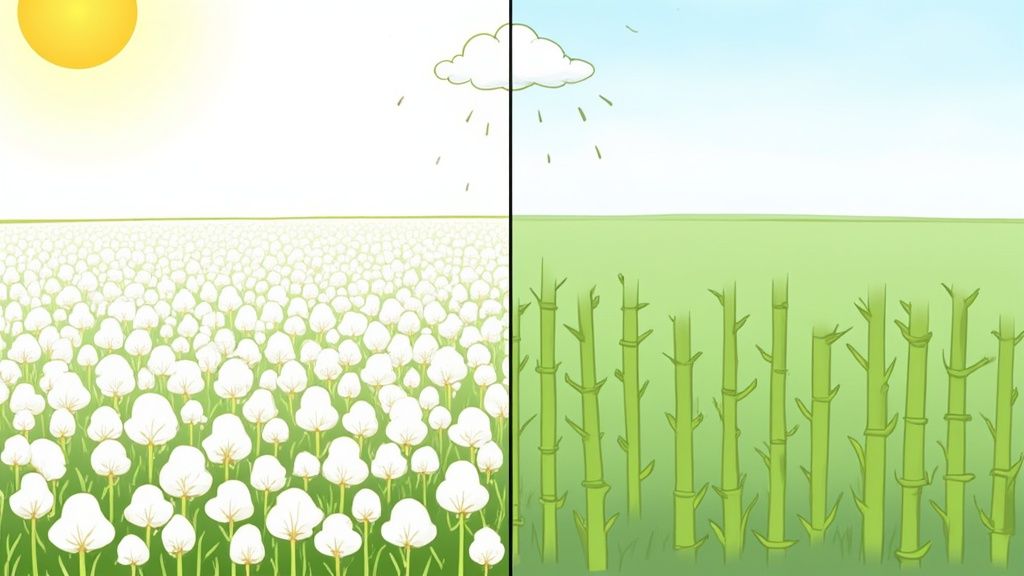
This is where things get really interesting. Both fabrics have some seriously green credentials, but they also have some pretty significant drawbacks. The "better" choice isn't always obvious and often comes down to which environmental trade-offs you feel more comfortable making.
Let's follow the journey from plant to pajama for both of these materials.
How The Plants Are Grown
In the field, bamboo looks like an environmental superhero. It's one of the fastest-growing plants on the planet, shooting up like a weed without needing much help from us.
Here’s why growing bamboo gets so much praise:
- Minimal Water Needs: Bamboo is technically a grass, and it's mostly rain-fed. It requires way less irrigation than notoriously thirsty crops like conventional cotton.
- No Pesticides Required: It has a natural antimicrobial agent, often called bamboo-kun, that helps it fight off pests and fungi on its own. That means farmers don't have to douse it in harsh chemicals.
- Improves the Soil: Its dense root system is great for preventing soil erosion. Plus, when it's harvested, the stalks are cut, leaving the roots in place to regenerate and enrich the soil for the next go-around.
Organic cotton, on the other hand, comes from a plant that has a bit of a reputation for being demanding. But the key word here is organic, and those farming practices change everything.
While cotton is known for being a water-intensive crop, GOTS-certified organic cotton farming is much gentler on the planet than the conventional kind. It bans GMO seeds and toxic pesticides, relying on smarter, natural methods like crop rotation to keep the soil healthy and pests at bay.
The Critical Difference: Processing The Fibers
Okay, so bamboo has a clear advantage in the field. But here’s where that advantage starts to get a little fuzzy. Turning tough, woody bamboo stalks into a silky-soft fabric is a heavy-duty industrial process. The most common method gives us what's known as bamboo viscose (or rayon).
This process involves dissolving the bamboo pulp in a chemical cocktail, usually including carbon disulfide and sodium hydroxide. If this isn't done in a closed-loop system—where the chemicals are captured and reused—those toxic substances can be discharged into the environment, polluting waterways and endangering workers.
The journey from plant to fabric is where the sustainability story often flips. While bamboo grows more sustainably, GOTS-certified organic cotton is processed more cleanly, offering a guarantee against toxic chemicals from farm to finished product.
This is exactly why certifications matter so much. An OEKO-TEX label on bamboo clothing is great because it ensures the final garment is free from harmful residues. What it doesn't guarantee, though, is that the manufacturing process itself was clean.
Processing organic cotton, especially under GOTS standards, is a much cleaner affair. The raw cotton is cleaned using non-toxic scourers and colored with low-impact dyes. There are no harsh chemical baths needed, which makes the entire production line safer for people and the planet.
A Nuanced Look at Water Usage
The water debate is a big one. It's absolutely true that growing conventional cotton is incredibly thirsty work; it can take a staggering 10,000 liters of water to produce just one kilogram of fiber. But organic farming slashes that number. Organic cotton uses around 62% less water than conventional methods, mainly because healthy, organic soil is much better at holding onto moisture. If you're curious, you can read more about these organic cotton stats to see the full picture.
Even with these improvements, bamboo generally still wins the prize for water conservation during cultivation, as it often thrives on rainwater alone. But again, you have to account for the water used during the chemical-heavy viscose process, which complicates the simple "bamboo uses less water" argument.
So, when you’re weighing the environmental impact, you're essentially choosing between two different paths:
- Organic Cotton: It comes from a thirstier plant (though it's a huge improvement over conventional cotton), but its processing is clean and chemical-free, especially when it's GOTS-certified.
- Bamboo Viscose: It starts with a wonderfully sustainable plant, but that green reputation can be tarnished by a chemical-heavy manufacturing process. If you go this route, look for brands that are transparent about using a closed-loop system to minimize the damage.
Protecting Your Baby’s Sensitive Skin
A baby’s skin isn’t just soft—it’s incredibly delicate, up to five times thinner than our own. This simple fact turns choosing a fabric from a style choice into a genuine health decision. When we put organic cotton and bamboo head-to-head, we're looking at two fabrics celebrated for being skin-friendly, but they go about protecting your baby in very different ways.
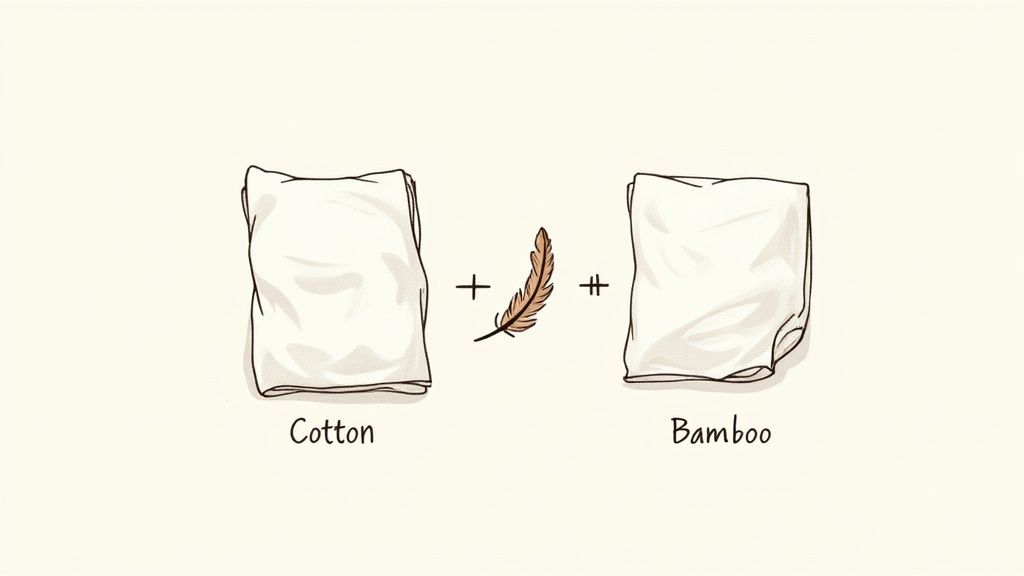
This decision is especially critical for little ones struggling with eczema or other skin sensitivities. The wrong material can easily trap heat and moisture or—even worse—introduce chemical irritants that trigger flare-ups and leave your baby feeling miserable.
So, let's break down how each fabric really performs when it comes to keeping your baby's skin calm, healthy, and happy.
The Purity of Organic Cotton
Organic cotton's biggest advantage is its natural purity. From the moment the seed is planted, it's grown without the cocktail of synthetic pesticides, herbicides, or fertilizers that plague conventional cotton. This means the raw fiber itself is free from nasty chemical residues right from the start.
That clean journey continues right through production. If you see a GOTS certification, it means the cotton was processed without harsh chemicals, chlorine bleach, or toxic dyes. This unwavering commitment to a pure process is why pediatricians and dermatologists often recommend it as the top choice for babies with severe allergies or eczema.
If your baby has a known sensitivity, or you just prefer a "better safe than sorry" mindset, an organic cotton bodysuit is one of the most reliable choices you can make. It’s a soft, breathable, and non-irritating barrier for the most delicate skin.
Bamboo's Gentle Touch and Antibacterial Claims
Bamboo fabric is famous for that silky-smooth feel that parents rave about. Its fibers are naturally round and smooth, so they glide over the skin with almost zero friction. For a squirmy, active baby, this can be a game-changer in preventing chafing and irritation.
You’ll also hear a lot about bamboo’s antibacterial properties. In its natural state, the plant contains an agent that helps it fight off pests. Some argue this quality carries over to the fabric, helping it stay fresh. However, it's worth noting that the Federal Trade Commission (FTC) has pointed out these natural properties are often lost during the chemical-heavy viscose process used to make the fabric.
Here's what it comes down to: A fabric's final safety profile has everything to do with how it was processed. Those little certification logos aren't just for show; they are your proof that the material touching your baby's skin is free from harmful stuff.
This is where bamboo gets a little more complex. The buttery softness is a huge win, but the potential for leftover manufacturing chemicals is a real concern without proper verification. This brings us to why certifications are so non-negotiable.
Why Certifications Are Your Best Friend
You can’t just take a brand’s word for it. Third-party certifications are the only real way to know if a fabric is truly safe for your baby. They act as an independent stamp of approval, verifying that a product meets strict safety and environmental standards.
Here are the two main labels you need to know:
- GOTS (Global Organic Textile Standard): This is the gold standard for organic textiles. It doesn't just look at the final product; it audits the entire supply chain, from farming to finishing. A GOTS logo guarantees the cotton is organically grown and processed without harmful chemicals like formaldehyde, heavy metals, or toxic dyes.
- OEKO-TEX Standard 100: This label is very common on bamboo clothing. Instead of the whole supply chain, it tests the final product for over 100 harmful substances. An OEKO-TEX certified pair of bamboo pajamas gives you peace of mind that any chemicals used to make the fabric have been washed out to safe levels.
Knowing what these labels mean helps you cut through the marketing noise. You can learn more about how thoughtful brands approach this in our guide on why bamboo pajamas are a smart choice for babies with sensitive skin.
Bottom line? For babies with extreme sensitivities or diagnosed skin conditions, GOTS-certified organic cotton is often the safest bet because of its inherent purity from farm to closet. For most babies, OEKO-TEX-certified bamboo is a wonderfully soft and gentle option, confirmed to be free from any harmful residues.
Durability, Care, and Long-Term Value
Baby clothes go through a lot. Between endless wash cycles, surprise spit-ups, and the general chaos of a little one's adventures, durability is a huge factor. When we talk about organic cotton vs. bamboo, this isn't just about which fabric lasts longer—it's about how well it holds up to the constant cleaning needed to keep things fresh for your baby.
This is where the practical side of parenting meets fabric science. A beautifully soft sleeper is pointless if it shrinks, pills, or falls apart after a few washes. The real value of your baby’s wardrobe comes down to choosing a material that can withstand the daily grind.
The Workhorse: Organic Cotton
When it comes to pure, rugged durability, organic cotton is the undisputed champ. Its fibers are naturally strong and resilient, giving the fabric a sturdy structure that can handle frequent, heavy-duty washing. This is the stuff you can toss in the machine on a warm or even hot cycle to tackle stubborn stains without a second thought.
Think of it as the reliable family minivan—it might not be the flashiest ride, but it’s built to last and gets the job done every single time. This toughness is a massive advantage for everyday essentials like onesies, play clothes, and burp cloths that are in constant rotation.
Organic cotton’s strength also makes it perfect for hand-me-downs. A well-made organic cotton piece can easily survive multiple kids, holding onto its shape and softness. That's how its initial investment really pays off, giving you value for years to come.
The Delicate Nature of Bamboo Viscose
On the other side of the ring, bamboo viscose trades some of that brute strength for its signature silky feel. Those long, smooth fibers that make it feel so luxurious are also more delicate than cotton's tough, shorter ones. This just means bamboo clothing needs a bit more TLC to stay at its best.
To keep that buttery texture and prevent pilling, you almost always have to wash bamboo garments in cold water on a gentle cycle. Throwing them in a hot wash or on a high-spin cycle can cause those fine fibers to break, leading to those annoying little fuzzballs and a loss of softness.
The real difference in care comes down to heat and agitation. Organic cotton can handle both, which makes getting stains out a breeze. Bamboo needs a gentle touch with cool water to protect its luxurious feel and prevent damage.
This gentler routine can be a downside for busy parents who just want to throw everything into one load. You'll need to separate your bamboo items and be more mindful of your washer's settings. It’s not hard, but it is one more thing to remember when you’ve already got a million things on your plate.
Fabric Care and Durability Showdown
At first glance, high-quality organic cotton and bamboo viscose often have similar price tags. The true measure of value, however, comes from how they perform over the long haul, factoring in both how long they last and how easy they are to care for.
To make things crystal clear, let's break down how they stack up side-by-side.
| Attribute | Organic Cotton | Bamboo Viscose |
|---|---|---|
| Washing Instructions | Machine wash warm or hot. Handles tough cycles. | Machine wash cold, gentle cycle. Avoid high heat. |
| Drying Instructions | Tumble dry on medium or high heat. | Tumble dry low or hang dry to prevent shrinkage. |
| Stain Removal | Very resilient. Can handle stronger stain treatments and hot water. | More sensitive. Requires gentle, pre-treatment methods. |
| Hand-Me-Down Potential | Excellent. Retains shape and strength through multiple children. | Good, but only if cared for properly. Prone to pilling or stretching over time. |
So, what’s the final verdict? For a parent who prioritizes convenience and wants clothes that can be passed down without any fuss, organic cotton offers incredible long-term value. Its ability to survive the laundry gauntlet means it will stay looking great for years. For more ideas on versatile baby clothing, our guide to sleeper outfits for babies has some fantastic suggestions.
However, if your priority is that unmatched softness and breathability from bamboo for sleepwear, the extra care might be a trade-off you’re willing to make. As long as you follow the washing instructions, bamboo clothing can still last a long time and provide incredible comfort, making it a valuable part of your baby’s wardrobe—especially for those cozy nighttime snuggles.
Making the Right Choice for Your Family
When you're standing at this crossroads—organic cotton vs. bamboo—the best choice really just boils down to your family's priorities. There’s no single "best" fabric overall, but there’s definitely a best fabric for your baby in a specific situation.
Think of it like picking the right tool for a job. You wouldn't try to hammer a nail with a screwdriver, right? The same idea applies here. Let's break down where each fabric truly shines.
When to Choose Organic Cotton
If purity and zero chemical exposure are your absolute top priorities, then GOTS-certified organic cotton is the clear winner. Its biggest strength is the clean, transparent journey from farm to closet.
For a baby with severe eczema, nagging allergies, or just incredibly sensitive skin, the guaranteed lack of harsh chemicals makes organic cotton a safe haven. It's the fabric you reach for when you need total peace of mind that nothing will irritate their delicate skin.
When to Choose Bamboo Viscose
Bamboo viscose really comes into its own when luxurious softness and temperature control are what you're after.
It's an absolute game-changer for sleepwear, especially for babies who run hot or get sweaty overnight. Bamboo's incredible ability to wick away moisture and regulate body temperature can mean the difference between a restless night and a sound sleep—for both of you. That buttery-soft feel is just the icing on the cake.
At the end of the day, it's pretty simple: Go with organic cotton for certified purity and its hypoallergenic nature. Opt for bamboo when you need next-level softness and a fabric that breathes.
Honestly, choosing either one is a huge step up from conventional fabrics. While the global demand for cotton keeps growing, organic cotton remains a small but mighty slice of the market, driven by parents who value quality and sustainability.
By zeroing in on what your little one needs most—whether it's relief for sensitive skin or a more comfortable night's sleep—you can confidently pick the perfect fabric for your family.
Answering Your Final Questions
Okay, so you've got the main differences down. But when you're standing in the aisle (or scrolling online) trying to decide between that organic cotton onesie and the bamboo pajamas, a few specific questions usually pop into your head. Let's tackle them head-on so you can feel 100% confident in your choice.
Is Bamboo Fabric Really Safe If It’s Made With Chemicals?
This is a huge one, and honestly, it’s the most important question to ask. It's true that turning tough bamboo pulp into that silky fabric we love involves a chemical process (the viscose method) that uses things like sodium hydroxide. Sounds a little scary, right?
But here’s the good news: the best brands use a “closed-loop” system. Think of it as a super-efficient recycling process where the chemicals are captured and reused over and over again, keeping them out of the environment. To be absolutely certain the fabric touching your baby is safe, just look for the OEKO-TEX Standard 100 certification. This is your peace of mind—it’s an independent seal that guarantees the final garment has been tested for over 100 nasty substances and is perfectly safe for your baby's skin.
Which One Is Better For a Baby With Eczema?
If your little one has been diagnosed with eczema or has incredibly sensitive skin, dermatologists almost always point to GOTS-certified organic cotton. The reason is simple: its purity is unmatched and certified.
The Global Organic Textile Standard (GOTS) is more than just an "organic" label. It's a guarantee that from the seed in the ground to the final stitch, the cotton was grown without synthetic pesticides and processed without harsh chemicals, bleaches, or irritating dyes.
While bamboo feels unbelievably soft, there’s a tiny chance that trace residues from the viscose process could trigger highly reactive skin. For managing a condition like eczema, the proven purity and incredible breathability of organic cotton make it the safest bet.
Why Does Organic Cotton Cost More Than Regular Cotton?
That higher price tag on organic cotton isn't just for a fancy label; it's a direct reflection of the incredible amount of care and ethical work that goes into making it. Growing things the old-fashioned way is just harder and yields a bit less.
Here’s a quick look at where the extra cost comes from:
- No Easy Outs: Instead of synthetic pesticides and GMO seeds, organic farmers use natural, labor-intensive methods like crop rotation and introducing beneficial insects to manage pests.
- A Healthier Planet: These sustainable practices build rich, healthy soil and prevent toxic chemical runoff from polluting local water sources.
- Rigorous Certification: Getting that GOTS seal of approval is a serious investment. It involves strict audits of the entire supply chain to ensure everyone is meeting high environmental and social standards.
At the end of the day, you're not just buying a piece of clothing. You're investing in a cleaner, safer product for your baby and supporting a much healthier farming ecosystem for everyone.
At Little Venture Co., we believe in wrapping your little ones in comfort that aligns with your values. Our faith-inspired bamboo sleepwear is OEKO-TEX certified, ensuring every piece is silky-soft, breathable, and completely safe for delicate skin. Explore our collection of zip rompers and daywear designed to bring comfort and inspiration to your family’s everyday moments.
